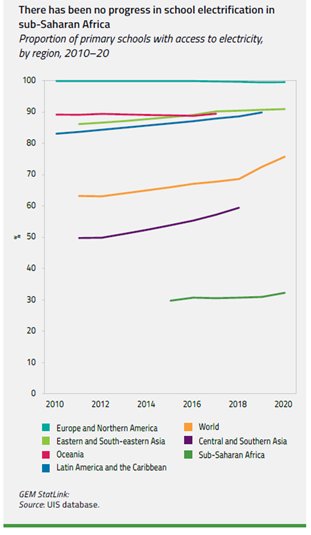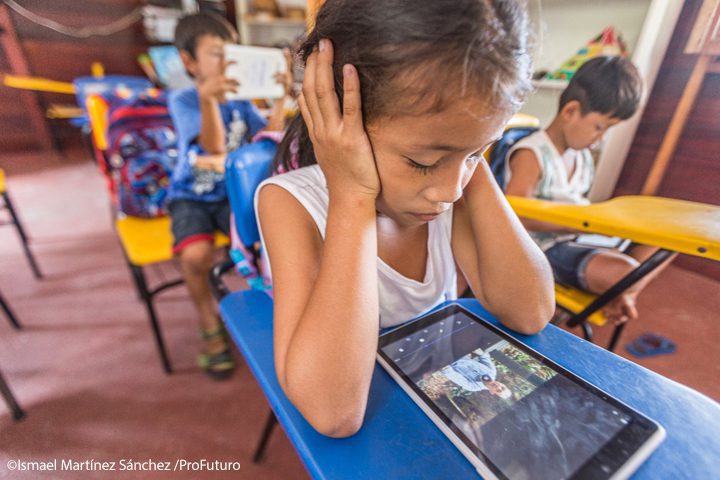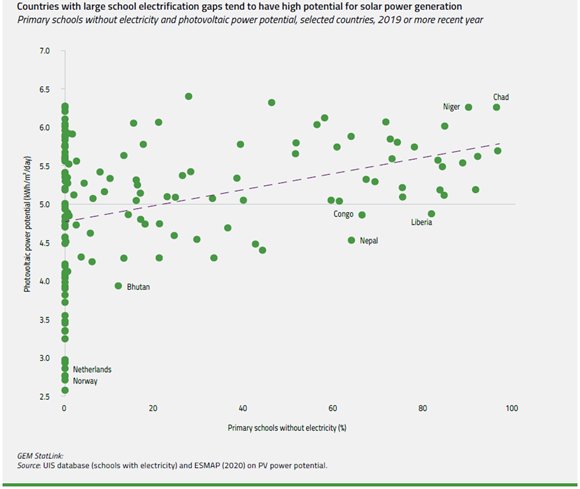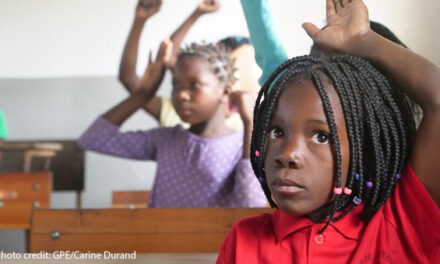This blog was written by the Global Education Monitoring Report team for the launch of the 2023 Report on technology in education.
Electricity is a basic need for schools, but many do not even have that. Can solar power help? The 2023 GEM Report out this week on technology in education looks at the potential.
Many schools are operating with no electricity at all
In 2021, 770 million people, or almost 9% of the global population, did not have access to electricity. That year, access to electricity in sub-Saharan Africa exceeded 50% for the first time, although it was still below 30% for those living in rural areas. Over a period of two decades, access to electricity increased by 38 percentage points in Central and Southern Asia, becoming almost universal, by 24 points in sub-Saharan Africa, and by 17 points in rural sub-Saharan Africa. It has been estimated that universal access to electricity by 2030 will require US$ 413 billion per year.
 The proportion of upper secondary schools with access to electricity follows the share of the population with access to electricity. By contrast, the proportion of primary schools with access to electricity lags behind access in the general population – by 15 percentage points globally and by 35 percentage points in Central and Southern Asia. This has led to one in four primary schools still not having electricity, a pre-requisite to benefiting from technology.
The proportion of upper secondary schools with access to electricity follows the share of the population with access to electricity. By contrast, the proportion of primary schools with access to electricity lags behind access in the general population – by 15 percentage points globally and by 35 percentage points in Central and Southern Asia. This has led to one in four primary schools still not having electricity, a pre-requisite to benefiting from technology.
The share of schools with electricity is particularly low in Central and Southern Asia and in sub-Saharan Africa, where it barely increased from 30% in 2015 to 32% in 2020. Without electricity, students and teachers cannot use digital technology in schools.
The expansion of solar panels can help fill the gap
Investment into large-scale infrastructure for expanding the electricity grid is an obvious but costly solution. Decentralised electric power generation offers an alternative, where the electricity consumed by the school is generated close by. This is not a new concept: diesel-powered generators have long been used for remote hospitals and schools, but they rely on the delivery of heavy fuel and therefore do not create true electricity independence.
More recently, PV electricity generation, i.e. solar panels that turn sunlight into an electric current, have created new options for decentralised power generation. The first recorded time when a solar panel was used to bring electricity to a primary school occurred over 50 years ago – in Niger in 1968.
As with many technologies, however, using solar panels did not take off when it first became available, but when it became affordable. This has occurred in the last 10 years. Of huge importance to low-income countries hoping to use this method to leapfrog to electricity, the global average price of solar panels dropped 88% between 2010 and 2021; prices for large-scale PV projects in Africa are even lower.
These price drops are partly due to the higher efficiency of modern PV panels, and partly to technological progress in the manufacturing process. Moreover, auxiliary technologies have matured, such as battery technology for buffering fluctuations and smart algorithms for managing local grids with many independent power inputs.
The feasibility of solar solutions for electricity generation is illustrated by their rapid adoption in Africa. Between 2010 and 2019, the number of people in Africa connected to solar minigrids increased 45-fold from only 39,000 to 1,736,000.
Schools lacking electricity are concentrated in climate zones with high solar potential
Among the 31 countries where more than half of all primary schools are without electricity, only three – Congo, Liberia and Nepal – have an average PV power potential below the global average.
Among all countries with primary schools that are not electrified, the theoretical PV potential of even the least sunny, Bhutan, is still one third higher than in the Netherlands, which has the second-highest installed solar PV capacity per capita after Australia. Climate change may change current patterns of average cloud coverage and solar panels are less efficient at higher temperatures. However, even taking these factors into account, the solar potential in Africa is not projected to diminish due to climate change.
Solar may not be sufficient on its own
However, being located in a favourable climate zone is not enough. Sophisticated technical and economic analyses and optimisation are required for the design of a feasible system, taking into account factors such as the site and buildings, solar radiation, load profiles, cost and the lifetime of components. Across Indian states and territories, the percentage of schools with solar power is highest in Chandigarh and Delhi, two of the richest and most urban territories in the country. This suggests that PV technology for school electrification is still driven by local technical and investment capacity potential.
Barriers to large-scale electrification of schools include upfront costs, procurement, vandalism and theft. Perhaps due to such challenges, as well as a scarcity of trained technicians for maintenance, some large-scale policies for solar electrification of schools in the early to mid-2010s did not meet their objectives. In Papua New Guinea, a solar lighting programme for rural schools equipped 2,400 classrooms, but a lack of maintenance meant ‘only a handful of units’ were still operating five years later. It may be crucial for the sustainability of projects to ensure that the wider community benefits from solar installations at schools. Part of the problem in Papua New Guinea was that solar panels installed at schools were frequently vandalised or stolen because their exclusive benefit to the school did not align with local understandings of common property rights.
A promising – but challenging – approach is to integrate school and community electrification in the form of microgrids, local electrical grids with defined electrical boundaries, acting as single and controllable entities. But school electrification can be designed to also benefit households even without microgrids. Under the award-winning Solar Cow initiatives, students take portable batteries to school and charge them during the school day. The batteries are sufficient to charge mobile phones and power lights and a radio at home. Pilots in Kenya and the United Republic of Tanzania are benefiting 550 households, and the initiative plans to expand to the Democratic Republic of Congo, Indonesia and Rwanda.
Finally, technologies that allow schools to exploit solar energy can provide benefits besides electricity. Direct exposure to solar UV radiation is surprisingly effective at disinfecting water. Sunlight can be captured for heating school buildings through technologies that optimise window area and design against insulation. Solar energy can even be used for cooling. Besides electric air conditioning powered by photovoltaics, ‘solar thermal’ or ‘solar thermo-mechanical’ systems use solar energy to directly cool classrooms.
***
The potential for solar-driven electricity in schools is exciting given the benefits to be drawn from learning through technology and the importance of children gaining digital skills relevant for the world of work. As we discuss in the 2023 GEM Report, the right to education is increasingly synonymous with the right to meaningful connectivity. Investing in low-cost, high-reach and fast-growing technologies such as solar panels to improve our education is an approach our report celebrates: it is a use of technology that meets learners’ needs, not an investment in technology for technology’s sake.
Read the report
Share the social media materials
See the 20 background papers and other online resources







This post reminds us that, with the right vision and technology, we can make education more accessible and sustainable for all. Thank you for shedding light on this crucial topic and for your dedication to making a positive difference in the world.